Secreted Amyloid Precursor Protein-Alpha Promotes Arc Protein Synthesis in Hippocampal Neurons
- PMID: 31474829
- PMCID: PMC6702288
- DOI: 10.3389/fnmol.2019.00198
Secreted Amyloid Precursor Protein-Alpha Promotes Arc Protein Synthesis in Hippocampal Neurons
Abstract
Secreted amyloid precursor protein-α (sAPPα) is a neuroprotective and memory-enhancing molecule, however, the mechanisms through which sAPPα promotes these effects are not well understood. Recently, we have shown that sAPPα enhances cell-surface expression of glutamate receptors. Activity-related cytoskeletal-associated protein Arc (Arg3.1) is an immediate early gene capable of modulating long-term potentiation, long-term depression and homeostatic plasticity through regulation of α-amino-3-hydroxy-5-methyl-4-isoxazolepropionic acid receptor localization. Accordingly, we hypothesized that sAPPα may enhance synaptic plasticity, in part, by the de novo synthesis of Arc. Using primary cortical and hippocampal neuronal cultures we found that sAPPα (1 nM, 2 h) enhances levels of Arc mRNA and protein. Arc protein levels were increased in both the neuronal somata and dendrites in a Ca2+/calmodulin-dependent protein kinase II-dependent manner. Additionally, dendritic Arc expression was dependent upon activation of mitogen-activated protein kinase and protein kinase G. The enhancement of dendritic Arc protein was significantly reduced by antagonism of N-methyl-D-aspartate (NMDA) and nicotinic acetylcholine (α7nACh) receptors, and fully eliminated by dual application of these antagonists. This effect was further corroborated in area CA1 of acute hippocampal slices. These data suggest sAPPα-regulated plasticity within hippocampal neurons is mediated by cooperation of NMDA and α7nACh receptors to engage a cascade of signal transduction molecules to enhance the transcription and translation of Arc.
Keywords: Alzheimer’s disease; Arc/Arg3.1; FUNCAT-PLA; NMDA; PKG; plasticity; sAPPα; α7nACh.
Figures


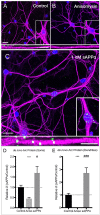
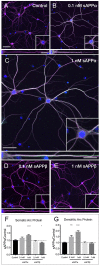

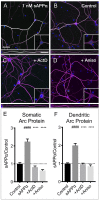
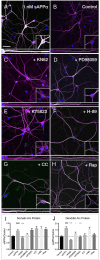
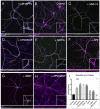

Similar articles
-
Secreted Amyloid Precursor Protein-Alpha Enhances LTP Through the Synthesis and Trafficking of Ca2+-Permeable AMPA Receptors.Front Mol Neurosci. 2021 Apr 1;14:660208. doi: 10.3389/fnmol.2021.660208. eCollection 2021. Front Mol Neurosci. 2021. PMID: 33867938 Free PMC article.
-
Glutamate Receptor Trafficking and Protein Synthesis Mediate the Facilitation of LTP by Secreted Amyloid Precursor Protein-Alpha.J Neurosci. 2019 Apr 24;39(17):3188-3203. doi: 10.1523/JNEUROSCI.1826-18.2019. Epub 2019 Feb 25. J Neurosci. 2019. PMID: 30804097 Free PMC article.
-
A C-terminal peptide from secreted amyloid precursor protein-α enhances long-term potentiation in rats and a transgenic mouse model of Alzheimer's disease.Neuropharmacology. 2019 Oct;157:107670. doi: 10.1016/j.neuropharm.2019.107670. Epub 2019 Jun 13. Neuropharmacology. 2019. PMID: 31202608
-
The Arc of cognition: Signaling cascades regulating Arc and implications for cognitive function and disease.Semin Cell Dev Biol. 2018 May;77:63-72. doi: 10.1016/j.semcdb.2017.09.023. Semin Cell Dev Biol. 2018. PMID: 29559111 Free PMC article. Review.
-
BDNF-induced local protein synthesis and synaptic plasticity.Neuropharmacology. 2014 Jan;76 Pt C:639-56. doi: 10.1016/j.neuropharm.2013.04.005. Epub 2013 Apr 16. Neuropharmacology. 2014. PMID: 23602987 Review.
Cited by
-
Secreted Amyloid Precursor Protein-Alpha Enhances LTP Through the Synthesis and Trafficking of Ca2+-Permeable AMPA Receptors.Front Mol Neurosci. 2021 Apr 1;14:660208. doi: 10.3389/fnmol.2021.660208. eCollection 2021. Front Mol Neurosci. 2021. PMID: 33867938 Free PMC article.
-
Secreted Amyloid Precursor Protein Alpha, a Neuroprotective Protein in the Brain Has Widespread Effects on the Transcriptome and Proteome of Human Inducible Pluripotent Stem Cell-Derived Glutamatergic Neurons Related to Memory Mechanisms.Front Neurosci. 2022 May 26;16:858524. doi: 10.3389/fnins.2022.858524. eCollection 2022. Front Neurosci. 2022. PMID: 35692428 Free PMC article.
-
Age-Dependent Dysregulation of APP in Neuronal and Skin Cells from Fragile X Individuals.Cells. 2023 Feb 27;12(5):758. doi: 10.3390/cells12050758. Cells. 2023. PMID: 36899894 Free PMC article.
-
Rho-associated kinases contribute to the regulation of tau phosphorylation and amyloid metabolism during neuronal plasticity.Pharmacol Rep. 2021 Oct;73(5):1303-1314. doi: 10.1007/s43440-021-00279-3. Epub 2021 Jun 1. Pharmacol Rep. 2021. PMID: 34060063
-
Amyloid Beta Dynamics in Biological Fluids-Therapeutic Impact.J Clin Med. 2021 Dec 20;10(24):5986. doi: 10.3390/jcm10245986. J Clin Med. 2021. PMID: 34945282 Free PMC article. Review.
References
LinkOut - more resources
Full Text Sources
Miscellaneous

